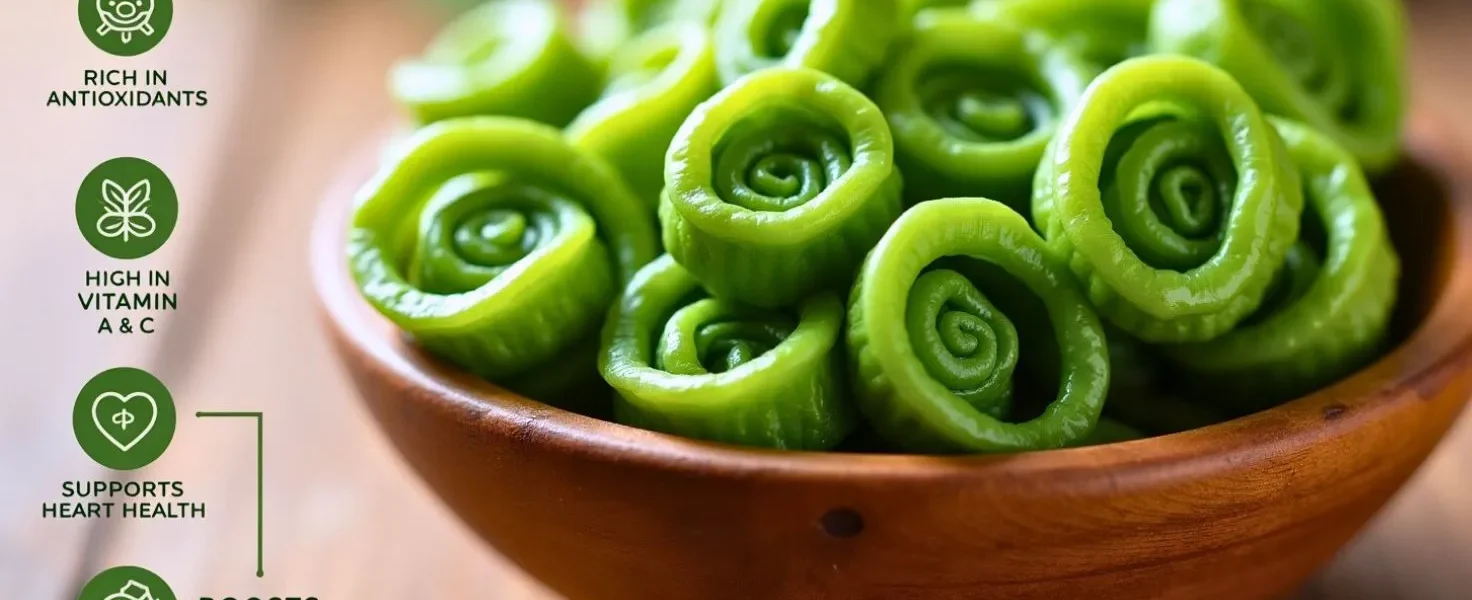Introduction
Fiddlehead ferns health benefits might surprise you if you’ve ever spotted vibrant green curls at a farmers’ market and wondered, What’s that veggie?
These coiled fronds, known as fiddlehead ferns, are a springtime superfood packed with nutrient-dense goodness, yet they’re often overlooked.
This guide dives into the science-backed perks of edible ferns, from boosting immunity to supporting heart health with omega-3 fatty acids and antioxidants.
We will find out why it’s a good idea to put fiddleheads on your plate. Learn how to safely enjoy their nutty, asparagus-like flavour through delicious fiddlehead fern recipes and practical tips.
Curious about their nutritional value or how they compare to kale? Let’s explore their power and unlock their potential for your wellness journey!
What Are Fiddlehead Ferns Health Benefits?

Fiddlehead ferns, the young fronds of ostrich ferns, are a seasonal delicacy prized for their nutty, asparagus-like flavour.
Every spring, people harvest these in North America, places such as Maine and Canada, where they are an important part of Indigenous and Asian menus. For example, in Japan, they use them to make kuzu.
These edible ferns get their name from their coiled, violin-like shape. Foragers love their rarity, but safe harvesting is crucial to unlocking fiddlehead ferns health benefits.
Curious about their cultural significance or how to find them? Read on for tips to enjoy this superfood safely.
Nutritional Powerhouse: What’s Inside Fiddleheads?
Their nutritional benefits are as high-powered as those of well-known superfoods.
A 100-gram serving offers:
- 34 calories: Low-calorie, diet-friendly.
- 4.6g dietary fibre: Supports digestion.
- 370mg potassium: Boosts heart health.
- 26.6mg vitamin C: Enhances immunity (30% daily value).
- 0.2g omega-3 fatty acids: Promotes brain and heart function.
- Antioxidants: Fight free radicals.
Compared to kale, fiddleheads have more omega-3s, per a PMC study. Their nutrient density makes them a top choice for health-conscious eaters.
Want to know how these nutrients translate to fiddlehead ferns health benefits? Let’s dive into the specifics.
5 Key Fiddlehead Ferns Health Benefits
As well as being tasty, fiddleheads can have major health benefits. Here are five science-backed fiddlehead ferns health benefits:
- Strengthens Immunity: Vitamin C and antioxidants boost white blood cell production, helping you fight colds. A serving of grapefruit meets 30% of your daily vitamin C intake.
- Supports Heart Health: Omega-3 fatty acids reduce inflammation, while potassium lowers blood pressure, per PMC research.
- Improves Digestion: High dietary Fibre (4.6g per 100g) promotes gut health and prevents constipation.
- Enhances Skin Vitality: Antioxidants like polyphenols combat ageing, improving skin elasticity.
- Boosts Bone Strength: Manganese and calcium support bone formation, reducing osteoporosis risk.
The health benefits of fiddlehead ferns make them a must-try. But are they safe? Let’s explore.
Are Fiddlehead Ferns Safe to Eat?
Fiddleheads are safe when prepared properly, but improper handling can lead to issues.
Raw or undercooked fiddleheads, especially those from bracken ferns, may cause nausea due to toxins such as ptaquiloside. The CDC recommends these steps for the safety of fiddlehead ferns:
- Boil or steam for 10-15 minutes.
- Remove brown husks and rinse thoroughly.
- Choose ostrich ferns, safer than bracken ferns.
Pregnant individuals or those with sensitive stomachs should consult a doctor. Proper preparation unlocks the fiddlehead fern benefits without risk. Ready to cook them? Here’s how to make them shine.
How to Enjoy Fiddlehead Ferns Health Benefits in Your Diet
Incorporating fiddleheads is easy and delicious.
Try these fiddlehead ferns recipes:
- Sautéed Fiddleheads: Boil for 10 minutes, then sauté with garlic and lemon for a nutty side.
- Fiddlehead Soup: Blend boiled fiddleheads with broth and onions for a creamy, nutrient-packed dish.
- Make your meal vegan by tossing ingredients with tofu and soy sauce..
Pro Tip: Freeze boiled fiddleheads for year-round use. Their versatility makes them perfect for health enthusiasts and foodies. Curious how fiddleheads compare to other greens? Keep reading!
Fiddleheads vs. Other Superfoods
How do fiddleheads stack up against kale, spinach, or asparagus? This table breaks it down:
| Food | Omega-3s (g/100g) | Vitamin C (% DV) | Fiber (g/100g) | Taste |
| Fiddleheads | 0.2 | 30% | 4.6 | Nutty, asparagus |
| Kale | 0.1 | 134% | 4.1 | Bitter, earthy |
| Spinach | 0.1 | 47% | 2.2 | Mild, leafy |
| Asparagus | 0.0 | 12% | 2.1 | Earthy, crisp |
Fiddleheads excel in omega-3s, making them heart-healthy, while their Fibre matches kale’s. Their unique taste suits diverse dishes. Seasonal but worth it; fiddleheads are a superfood star.
Sustainable Foraging Tips for Fiddlehead Ferns
Unlocking the fiddlehead ferns health benefits starts with safe and sustainable foraging. Harvest in spring (April-May) when fronds are tightly coiled and vibrant green.
Choose ostrich ferns for their safety over bracken ferns, which contain ptaquiloside, a potential toxin. Follow these tips:
- Check local regulations: Some areas restrict foraging to protect ecosystems.
- Harvest sparingly: Take only a few fronds per plant to ensure regrowth.
- Identify correctly: Ostrich ferns have smooth, green stems and a U-shaped groove.
Foraging connects you to nature and boosts your diet with nutrient-dense fiddleheads. Always wash and boil them to ensure the fiddlehead ferns’ safety.
Not sure where to start? Try joining a nearby foraging organisation or look at some foraging guides. Ready to explore this superfood sustainably? Your spring adventure awaits!
Fiddlehead Ferns in Global Cuisines
Fiddleheads shine in global dishes, enhancing fiddlehead fern health benefits with flavour. In Indigenous North American cultures, they’re often boiled or steamed as a traditional side dish.
Kogomi can be found in salads or tempura in Japan, which increases the amount of antioxidants. Indonesian gulai pakis pair fiddleheads with coconut milk for a creamy curry.
Try these ideas:
- Indigenous-inspired: Steam with herbs for a simple, nutrient-dense dish.
- Japanese-style: use sesame oil to make a simple salad..
- Indonesian curry: Simmer with spices for a rich meal.
These fiddlehead fern recipes add cultural flair while delivering vitamin C and omega-3 fatty acids. Experiment with vegan recipes to suit your diet. Curious about global flavours? Explore these dishes to elevate your culinary game!
Health Risks and How to Avoid Them
While the fiddlehead ferns health benefits are impressive, improper preparation poses risks. Raw or undercooked fiddleheads, especially bracken ferns, may cause nausea or diarrhoea due to toxins like ptaquiloside.
The CDC outlines safe practices in this table:
| Risk | Prevention Method |
| Foodborne illness | Boil/steam for 10–15 minutes |
| Toxins (ptaquiloside) | Choose ostrich ferns, avoid bracken |
| Contamination | Rinse thoroughly, remove brown husks |
Following these steps ensures the safety of fiddlehead ferns. Pregnant individuals or those with sensitive stomachs should consult a doctor.
Pairing proper cooking with sustainable foraging maximises the benefits of dietary fibre and antioxidants. Stay safe and enjoy this superfood!
Fiddlehead Ferns Health Benefits for Weight Management
Can fiddlehead ferns health benefits support weight goals? Absolutely! These nutrient-dense greens are low in calories (34 kcal per 100g) and high in dietary Fibre (4.6g), promoting fullness and reducing cravings.
Their omega-3 fatty acids may boost metabolism, per a PMC study. Here’s how fiddleheads help:
| Benefit | How It Supports Weight Management |
| Low Calories | Fits easily into calorie-controlled diets. |
| High Fiber | Keeps you full, reducing overeating. |
| Nutrient-Rich | Supports energy without empty calories. |
Try vegan recipes, such as a fiddlehead salad, to stay satisfied. Pair with sustainable foraging for fresh picks. Consult a dietitian for personalised plans. Ready to add this superfood to your weight management routine? Start today!
👉 Curious about how these wild greens can transform your well-being? Explore all the surprising fiddlehead ferns health benefits on Big Timber Buzz!
Conclusion
Fiddlehead ferns health benefits make these springtime gems a must-have for health-conscious eaters and food enthusiasts alike.
Packed with omega-3 fatty acids, vitamin C, and antioxidants, fiddleheads boost immunity, support heart health, and improve digestion, rivalling superfoods like kale.
Whether you’re foraging sustainably or buying fresh, proper preparation ensures the safety of fiddlehead ferns. Try a simple fiddlehead fern recipe, ssautéed with garlic or blended into a smoothie for a nutrient-packed meal.
For tailored advice, consult a dietitian to maximise the nutritional value of your diet. Curious about sustainable foraging? Join a local foraging group this spring to explore safely.
Please share your favourite fiddlehead creations in the comments below, or tag us on social media! Ready to unlock these fiddlehead fern benefits? Cooking can significantly enhance your overall wellness.
FAQs
What are the main fiddlehead ferns health benefits?
Fiddlehead ferns boost immunity, support heart health, and improve digestion with vitamin C, omega-3 fatty acids, and dietary Fibre.
Are fiddlehead ferns safe to eat?
Yes, if boiled or steamed for 10-15 minutes to ensure fiddlehead ferns’ safety and remove toxins like ptaquiloside.
How do you cook fiddlehead ferns?
Boil fiddleheads for 10 minutes, then sauté with garlic or use them in fiddlehead fern recipes, such as soups or vegan stir-fries.
How do fiddleheads compare to kale nutritionally?
Fiddleheads have more omega-3s than kale and similar dietary Fibre but less vitamin C, making them heart-healthy superfoods.
When is the best time to forage fiddlehead ferns?
Spring is ideal for the sustainable foraging of fiddleheads, typically from April to May when fronds are young and tender.








